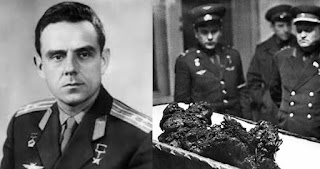The Remains of The Astronaut Vladimir Komarov, A Man Who Fell from Space, 1967.
The Remains of The Astronaut Vladimir Komarov, A Man Who Fell from Space, 1967.
Vladimir Mikhaylovich Komarov (Russian 16 March 1927 – 24 April 1967) was a Soviet test pilot, aerospace engineer, and cosmonaut. In October 1964, he commanded Voskhod 1, the first spaceflight to carry more than one crew member.
He became the first Soviet cosmonaut to fly in space twice when he was selected as the solo pilot of Soyuz 1, its first crewed test flight. A parachute failure caused his Soyuz capsule to crash into the ground after re-entry on 24 April 1967, making him the first human to die in a space flight.
He was declared medically unfit for training or spaceflight twice while he was in the program but continued playing an active role. During his time at the cosmonaut training center, he contributed to space vehicle design, cosmonaut training, evaluation and public relations.
Response to Komarov's death.
In his diary, Nikolai Kamanin recorded that the Soyuz 1 capsule crashed into the ground at 30–40 metres per second (98–131 ft/s) and that the remains of Komarov's body were an irregular lump 30 centimetres (12 in) in diameter and 80 centimetres (31 in) long.
Three hours after the capsule's crash, Keldysh, Tyulin, Rudenko, and other State Commission members visited the site. At 21:45 Kamanin accompanied Komarov's remains to the Orsk aerodrome, where they were loaded on an Il-18. Ten minutes before departure an An-12 landed with Kuznetsov and several cosmonauts.
Kamanin's aircraft arrived in Moscow in the early hours of the next morning. The aircraft had to divert to Sheremetyevo since all the other airfields around Moscow were closed to takeoffs or landings due to weather.
Konstantin Vershinin's orders were that Komarov's remains were to be photographed, then immediately cremated so that a state burial in the Kremlin wall could take place. The remains underwent a quick autopsy that morning, then were cremated.
On 25 April, a response to Komarov's death by his fellow cosmonauts was published in Pravda: "For the forerunners it is always more difficult. They tread the unknown paths and these paths are not straight, they have sharp turns, surprises and dangers.
But anyone who takes the pathway into orbit never wants to leave it. And no matter what difficulties or obstacles there are, they are never strong enough to deflect such a man from his chosen path. While his heart beats in his chest, a cosmonaut will always continue to challenge the universe. Vladimir Komarov was one of the first on this treacherous path."
When interviewed on 17 May by the newspaper Komsomolskaya Pravda, Yuri Gagarin alluded to the failure of the administration to listen to the concerns about the Soyuz module that the cosmonaut corps had identified, and maintained that Komarov's death should teach the establishment to be more rigorous in its testing and evaluation of "all the mechanisms of the spaceship, even more attentive to all stages of checking and testing, even more vigilant in our encounter with the unknown.
He has shown us how dangerous the pathway to space is. His flight and his death will teach us courage." In May 1967, Gagarin and Leonov criticised program head Vasily Mishin's "poor knowledge of the Soyuz spacecraft and the details of its operation, his lack of cooperation in working with the cosmonauts in flight and training activities," and asked Kamanin to cite him in the official crash report.












Comments
Post a Comment